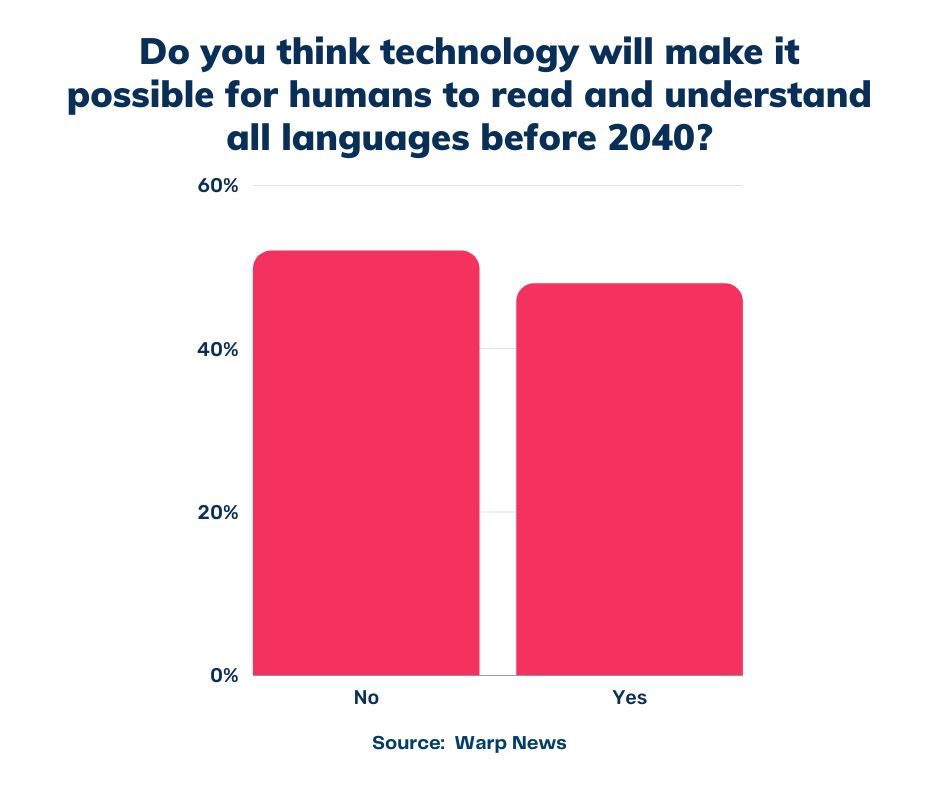
💡 Optimist’s Edge: No language barrier
Humanity has been working on machine translation for hundreds of years, but in the last ten years, progress has been exponential. We are close to a world with perfect machine translations of texts, removing a big language barrier for the world.
Share this story!
📉 What people believe
It is close, but no, a majority does not think technological progress will make it possible for us to read and understand all languages by the year 2040.

📈 Here are the facts
Translation is something humans have been working on for a long time:
- Al-Kindi, the father of Arab philosophy, developed techniques for systemic language translation, which laid the groundwork for modern machine translations, that today are used by, for example, Google Translate.
- The first patent for a “translation machine” was filed by a French engineer, Georges Artsrouni, in the 1930s.
- In 1954 the Georgetown-IBM experiment translated 49 Russian sentences into English for the first time in history. This achievement sparked worldwide interest and started a race to develop machine translations.
- In the mid-sixties, a report was published that expressed concern about the lack of progress, and funding for machine translation was decreased.
- One project that survived was SYSTRAN. In the 1970s the US Air Force started using it and later on it was the basis for AltaVista’s, and later Yahoo’s, BabelFish.
Now on an exponential path
Machine translation made steady progress, but a few years ago machine translations entered an exponential path. Until then the translations had been made based on rules and statistics, but now a new system based on neural networks is starting to be used.
Artificial neural networks mimic how the human brain learns and stores information. This is a big shift in artificial intelligence overall, as explained in the book Genius Makers by Cade Metz.
How accurate are they today?
A 2021 study found that Google Machine Translation was able to translate medical instructions for patients with an accuracy rate of 94 percent for Spanish, 90 percent for Tagalog, and 82.5 percent for Korean. In another study involving English to Swedish translation of an opinion piece, the Google MT output required an average of three edits per sentence.
How fast do they improve?
According to translation company Lionbridge, the accuracy of Neural Machine Translation is improving by three to seven percent every year.
But increased computing capacity combined with more training data means that the future progress is more likely exponential. Meaning that accuracy will double every few years.
Three percent yearly improvement means 24 years to double, and seven percent means 10 years. It will likely be faster than that.
💡 Optimist’s Edge
Today you can use Google Translate to understand over 100 languages. You can translate any text and almost always get a basic understanding of what it is about. But that doesn’t mean you'll understand all of the details in the text. The text is also not enjoyable to read.
With perfect translations that will change, opening up a whole world of texts.
👇 How to get the Optimist’s Edge
Machine translations are already useful today. If you want to translate a text, the machine does the majority of the work and you can concentrate on fixing the errors and making it sound more authentic. This saves a lot of time.
- The two biggest and most accurate machine translation tools are Google Translate and DeepL.
- Redokun is a translation company that also uses translation memory, which after a while could make your translations more accurate and faster.
- The best translation quality has been seen in content related to computer software, legal services, and telecommunications. How come?
- If you work as a translator you need to learn how to work with machine translation. You will still have a job doing traditional translations for some time, but that is a job that probably won’t be around in 15-20 years.
- Become an expert in helping companies and organizations use machine translations to save time and money, and be able to translate much more of the texts they produce. Making it easier to keep global organizations connected.
- If you have a language education or think of getting one, consider adding machine learning or computer science to the mix. With those skills, you’ll be highly sought after, or you can start your own business.
By becoming a premium supporter, you help in the creation and sharing of fact-based optimistic news all over the world.


